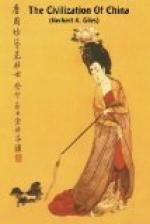Pushing farther back into antiquity, we easily reach a time when the inhabitants of the Middle Kingdom “held learning in high esteem, while our own painted forefathers were running naked and houseless in the woods, and living on berries and raw meat.” In inventive, mechanical and engineering aptitudes the Chinese have always excelled; as witness—only to mention a few—the art of printing (see below); their water-wheels and other clever appliances for irrigation; their wonderful bridges (not to mention the Great Wall); the “taxicab,” or carriage fitted with a machine for recording the distance traversed, the earliest notice of which takes us back to the fourth century A.D.; the system of fingerprints for personal identification, recorded in the seventh century A.D.; the carved ivory balls which contain even so many as nine or ten other balls, of diminishing size, one within another; a chariot carrying a figure which always pointed south, recorded as in existence at a very early date, though unfortunately the specifications which have came down to us from later dates will not work out, as in the case of the “taxicab.” The story goes that this chariot was invented about 1100 B.C., by a wonderful hero of the day, in order to enable an ambassador, who had come to the court of China from a far distant country in the south, to find his way expeditiously home. The compass proper the Chinese cannot claim; it was probably introduced into China by the Arabs at a comparatively late date, and has been confused with the south-pointing chariot of earlier ages. As to gunpowder, something of that nature appears to have been used for fireworks in the seventh century; and something of the nature of a gun is first heard of during the Mongol campaigns of the thirteenth century; but firearms were not systematically employed until the fifteenth century. Add to the above the art of casting bronze, brought to a high pitch of excellence seven or eight centuries before the Christian era, if not earlier; the production of silk, mentioned by Mencius (372-289 B.C.) as necessary for the comfort of old age; the cultivation of the tea-plant from time immemorial; also the discovery and manufacture of porcelain some sixteen centuries ago, subsequently brought to a perfection which leaves all European attempts hopelessly out-classed.
In many instances the Chinese seem to have been so near and yet so far. There is a distinct tradition of flying cars at a very remote date; and rough woodcuts have been handed down for many centuries, showing a car containing two passengers, flying through the clouds and apparently propelled by wheels of a screw pattern, set at right angles to the direction in which the travellers are proceeding. But there is not a scrap of evidence to show what was the motive power which turned the wheels. Similarly, iron ships are mentioned in Chinese literature so far back as the tenth century, only, however, to be ridiculed as an impossibility; the circulation of the blood is




